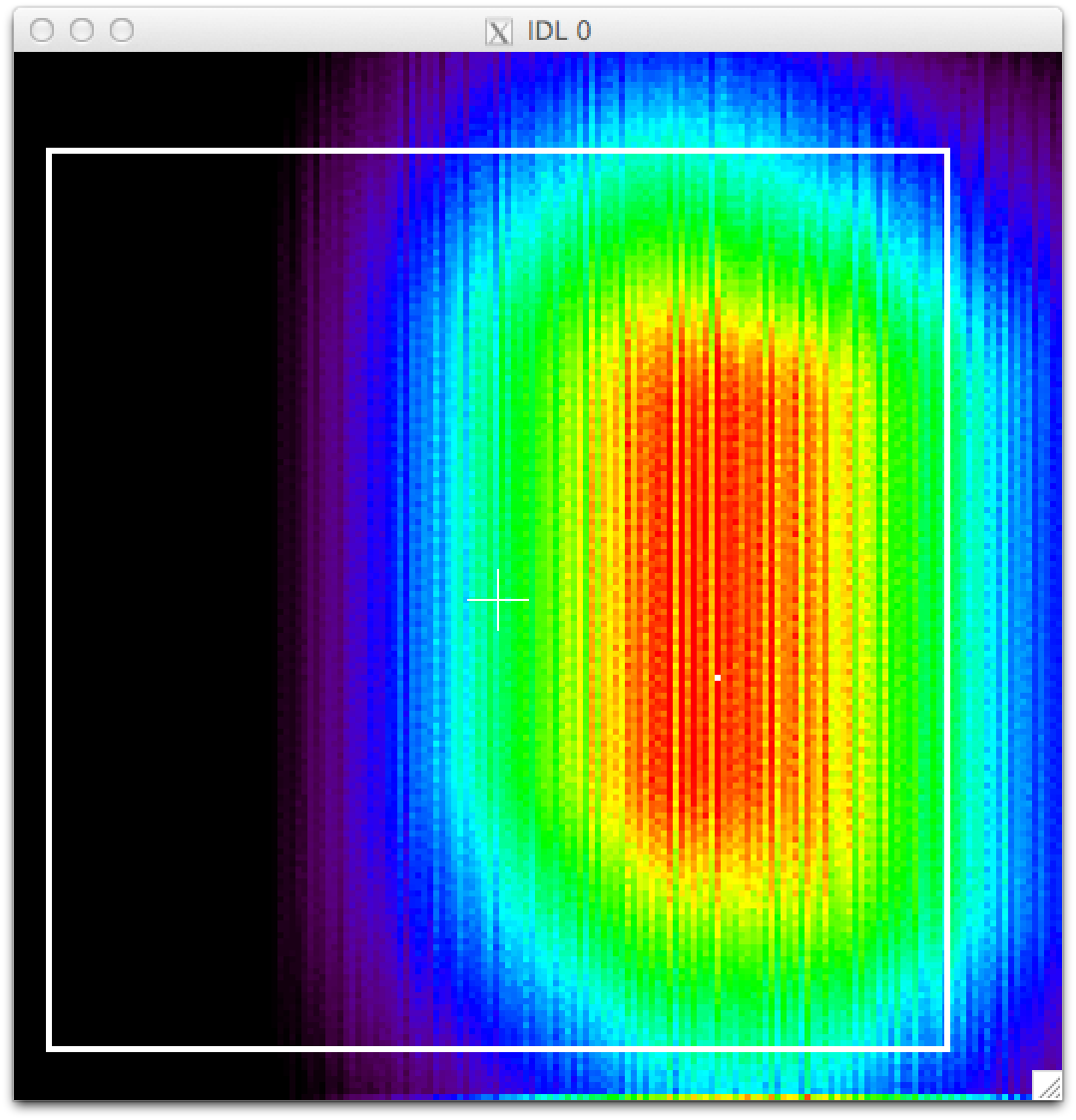|
Size: 2959
Comment:
|
← Revision 35 as of 2015-10-22 19:56:12 ⇥
Size: 10320
Comment: As the pipeline changes, so do the results of the tests change
|
| Deletions are marked like this. | Additions are marked like this. |
| Line 1: | Line 1: |
| ## page was renamed from OffProcNika2Run1ObsModeTests | |
| Line 12: | Line 13: |
| Positions of Jupiter and satellites according to JPL Horizon: | From the positions of Jupiter and satellites according to JPL Horizon, here are the derived distances and position angles. |
| Line 14: | Line 15: |
| || Date__(UT)__HR:MN || R.A. (ICRF/J2000.0) DEC || R.A. (a-apparent) DEC || Azi_(a-appr) || Elev || ||<-5> '''Jupiter''' || || 2015-Oct-21 04:00 || 11 04 41.66 +06 57 55.2 || 11 05 29.78 +06 52 51.5 || 90.1955 || 11.7233 || || 2015-Oct-21 04:30 || 11 04 42.53 +06 57 50.1 || 11 05 30.65 +06 52 46.3 || 94.8005 || 17.7130 || || 2015-Oct-21 05:00 || 11 04 43.39 +06 57 44.9 || 11 05 31.51 +06 52 41.2 || 99.6214 || 23.6612 || || 2015-Oct-21 05:30 || 11 04 44.25 +06 57 39.7 || 11 05 32.37 +06 52 36.0 || 104.7930 || 29.5213 || || 2015-Oct-21 06:00 || 11 04 45.11 +06 57 34.6 || 11 05 33.23 +06 52 30.8 || 110.4826 || 35.2356 || || 2015-Oct-21 06:30 || 11 04 45.97 +06 57 29.4 || 11 05 34.09 +06 52 25.6 || 116.9020 || 40.7272 || || 2015-Oct-21 07:00 || 11 04 46.82 +06 57 24.2 || 11 05 34.95 +06 52 20.5 || 124.3197 || 45.8897 || || <-5> '''Ganymede''' || || 2015-Oct-21 04:00 || 11 04 30.32 +06 59 10.6 || 11 05 18.44 +06 54 07.0 || 90.2068 || 11.7734 || || 2015-Oct-21 04:30 || 11 04 31.36 +06 59 04.2 || 11 05 19.48 +06 54 00.5 || 94.8123 || 17.7624 || || 2015-Oct-21 05:00 || 11 04 32.40 +06 58 57.7 || 11 05 20.52 +06 53 54.0 || 99.6341 || 23.7095 || || 2015-Oct-21 05:30 || 11 04 33.44 +06 58 51.2 || 11 05 21.56 +06 53 47.6 || 104.8076 || 29.5686 || || 2015-Oct-21 06:00 || 11 04 34.48 +06 58 44.7 || 11 05 22.61 +06 53 41.0 || 110.5000 || 35.2816 || || 2015-Oct-21 06:30 || 11 04 35.53 +06 58 38.2 || 11 05 23.66 +06 53 34.5 || 116.9237 || 40.7714 || || 2015-Oct-21 07:00 || 11 04 36.57 +06 58 31.6 ||11 05 24.71 +06 53 27.9 || 124.3474 || 45.9318 || |
||<-9> In the Azimuth-Elevation reference frame || || Time || dist. || P.A. || dist. || P.A. || dist || P.A. || dist. || P.A. || || ||(arcsec)||(degree)||(arcsec)||(degree)||(arcsec)||(degree)||(arcsec)||(degree)|| || ||<-2> Io ||<-2> Europa ||<-2> Ganymede ||<-2> Callisto || ||2015-Oct-21 04:00 UT || 4 || 38 || 83 || -167 || 184 || 12 || 244 || 10 || ||2015-Oct-21 04:30 UT || 3 || 152 || 78 || -166 || 182 || 12 || 247 || 10 || ||2015-Oct-21 05:00 UT || 10 || -178 || 74 || -165 || 178 || 13 || 249 || 11 || ||2015-Oct-21 05:30 UT || 17 || -172 || 68 || -164 || 176 || 15 || 252 || 12 || ||2015-Oct-21 06:00 UT || 23 || -167 || 64 || -161 || 173 || 17 || 255 || 14 || ||2015-Oct-21 06:30 UT || 30 || -164 || 59 || -158 || 169 || 20 || 257 || 17 || ||2015-Oct-21 07:00 UT || 37 || -159 || 53 || -153 || 166 || 24 || 260 || 22 || ||<-9> In the ICRS (e.g. RA, Dec) Reference frame || ||2015-Oct-21 04:00 UT || 4 || -91 || 83 || 113 || 184 || -65 || 244 || -63 || ||2015-Oct-21 04:30 UT || 3 || 150 || 78 || 113 || 182 || -65 || 247 || -63 || ||2015-Oct-21 05:00 UT || 10 || 126 || 73 || 113 || 179 || -66 || 249 || -63 || ||2015-Oct-21 05:30 UT || 17 || 121 || 69 || 113 || 176 || -66 || 252 || -63 || ||2015-Oct-21 06:00 UT || 24 || 119 || 64 || 112 || 173 || -66 || 255 || -63 || ||2015-Oct-21 06:30 UT || 30 || 118 || 58 || 112 || 169 || -66 || 257 || -63 || ||2015-Oct-21 07:00 UT || 37 || 117 || 53 || 112 || 166 || -66 || 260 || -63 || |
| Line 37: | Line 42: |
| * Pipeline version: observe@nika2-a.iram.es / branch/Nika2Obs on 2015-10-22:01:00 UT. | |
| Line 40: | Line 46: |
| * param.map_proj: = ‘azel’ * param.decor_cm_dmin = 40. |
* param.map_proj = ‘azel’ * param.decor_method = ‘COMMON_MODE' * results: Could not reduce this scan. Even with ‘COMMON_MODE’ (i.e. not masking the source), we get the following error message: % NK_ERROR: FATAL: There are 7293 holes in the derived common_mode. |
| Line 48: | Line 55: |
| * Pipeline version: observe@nika2-a.iram.es / branch/Nika2Obs on 2015-10-22:01:00 UT. | |
| Line 49: | Line 57: |
| * param.map_xsize = 650 * param.map_ysize = 650 |
* param.map_xsize = 700 * param.map_ysize = 700 |
| Line 52: | Line 60: |
| * param.decor_cm_dmin = 40. | * param.decor_cm_dmin = 60. * param.decor_method = ‘COMMON_MODE_KIDS_OUT’ * results: * Ganymede and Callisto are both seen at 1mm (left) and 2mm (right) images. The measured distances are 181 arcsec for Ganymede, 250 arcsec for Callisto, and position angle (from top, leftward) of 13 degree and 11 degree respectively, a good match for this observation taken close to 05:00 UT . (Not the that the images are displayed with IDL !order = 1 so that the pixel (0, 0) of the maps are at the top, left of the displayed image. With such !order, the results are as expected. The expected position of Europa is also marked, put it is too close from jupiter. {{attachment:20151021s24_i1_with_satellites.png||height=415}} {{attachment:20151021s24_i2_with_satellites.png||height=415}} * The coverage at 2mm (grid.nhits_2) is displayed below. The total map is 11.6 x 11.6 arc min on a side. The white square shows the 10 x 10 arc min area indicated by the pako command. Within this area, the coverage is not homogenous, from 130 hits on the edge to 330 in the middle. The dashed area correspond to 250 hits and above, and is 40 square arcmin (6.3 x 6.3 arc min). Maybe we should add a Pako message saying that the homogenous coverage is closer to 6’ x 6’. {{attachment:20151021s24_nhits2.png||height=415}} * Observation mode seems OK, except for the remark of the coverage map. === nkotf in azel reference, scan at constant elevation === * Pako command: nkotf 3 10 0 0 30 50azel * Scan number: [[NK2015_Oct21 | 20151021s27]] * Note: None * Pipeline version: observe@nika2-a.iram.es / branch/Nika2Obs on 2015-10-22:01:00 UT. * pipeline param: * param.map_xsize = 700 * param.map_ysize = 700 * param.map_proj: = ‘azel’ * param.decor_cm_dmin = 60. * param.decor_method = ‘COMMON_MODE_KIDS_OUT’ * results: * In the 2mm image (left), Ganymede is found at 180”, PA=13, Callisto at 254”, PA = 10. This is in good agreement with Horizon. (again, with convention !order = 1). * In the array 2 nhits map (right), the scanning at constant elevation is clear. The coverage is inhomogenous. The 3 x 10 arc min expected from the scan is shown by the white rectangle. The coverage in this rectangle goes from 80 to 240 hits... {{attachment:20151021s27_i2_with_satellites.png||height=415}} {{attachment:20151021s27_nhits2.png||height=415}} === nkotf in azel reference, scan at constant azimuth === * Pako command: nkotf 10 3 90 0 15 50azel (i.e. scan along elevation) * Scan number: [[NK2015_Oct21 | 20151021s27]] * Note: None * Pipeline version: observe@nika2-a.iram.es / branch/Nika2Obs on 2015-10-22:01:00 UT. * pipeline param: * param.map_xsize = 700 * param.map_ysize = 700 * param.map_proj: = ‘azel’ * param.decor_cm_dmin = 60. * param.decor_method = ‘COMMON_MODE_KIDS_OUT’ * results: * In the 2mm image (left), Ganymede is found at 181”, PA=12. It is barely visible. Callisto is not visible. This is due to the scanning along elevation, at a time (05:30 UT) where the satellite are almost along the scan axis (12 degree away only). This is in good agreement with Horizon. (again, with convention !order = 1). * In the array 2 nhits map (right), the scanning at constant azimuth is clear. The coverage is inhomogenous. The 3 x 10 arc min expected from the scan is shown by the white rectangle. The coverage in this rectangle goes from 112 to 236 hits... {{attachment:20151021s29_i2_with_satellites.png||height=415}} {{attachment:20151021s29_nhits2.png||height=415}} === nkotf in radec reference,scan along the RA axis === * Pako command: nkotf 10 10 00 0 15 50 radec (i.e. scan along RA) * Scan number: [[NK2015_Oct21 | 20151021s38]] * Note: None * Pipeline version: observe@nika2-a.iram.es / branch/Nika2Obs on 2015-10-22:01:00 UT. * pipeline param: * param.map_xsize = 700 * param.map_ysize = 700 * param.map_proj: = ‘radec’ * param.decor_cm_dmin = 60. * param.decor_method = ‘COMMON_MODE_KIDS_OUT’ * results: * Jupiter is not at the center of the map !!! * Neither Ganymede or Callisto are to be seen !!! * The following images display the map, with !order = 1 (left) and !order = 0 (right) {{attachment:20151021s31_i2_order1.png||height=415}}{{attachment:20151021s31_i2_order0.png||height=415}} * The following images display the Nits, with !order = 1 (left) and !order = 0 (right). The black cross marks the measured position of jupiter, and the losange (white left, black right) marks the expected position of ganymede, given its PA and distance to Jupiter. A possible reason for the non detection of Ganymede, is that it is in a region of the map with a low hits number, i.e. if the correct orientation is with !order = 0. This will be confirmed with scan 38 below. * The scan was correctly done along the X (RA) axis. But we are off center by 1/4 of the map size . {{attachment:20151021s31_nhits2_order1.png||height=415}}{{attachment:20151021s31_nhits_order0.png||height=415}} === nkotf in radec reference,scan along the Dec axis === * Pako command: nkotf 10 10 90 0 15 36 radec (i.e. scan along Dec) * Scan number: [[NK2015_Oct21 | 20151021s38]] * Note: None * Pipeline version: observe@nika2-a.iram.es / branch/Nika2Obs on 2015-10-22:01:00 UT. * pipeline param: * param.map_xsize = 700 * param.map_ysize = 700 * param.map_proj: = ‘radec’ * param.decor_cm_dmin = 60. * param.decor_method = ‘COMMON_MODE_KIDS_OUT’ * results: * Jupiter is not at the center of the map !!! * When displaying the image with '''!order = 1''', Ganynede is found at 169” of Jupiter, PA = -114, Callisto is found at 258”, PA = -117. While the distances are OK, the positions angle do not match the expectation in the ICRF reference frame. {{attachment:20151021s38_i2_order1_with_satellites.png||height=415}} * When displaying the image with '''!order = 0''', Ganynede is found at 169” of Jupiter, PA = -66, Callisto is found at 256”, PA = -63 which match reasonably well the expectation in the ICRF reference frame. {{attachment:20151021s38_i2_order0_with_satellites.png||height=415}} * The grid.nhits_2 confirm that the scan was done along the dec axis, but jupiter is not at the center of the map. The white square is the 10’x10’ expected map, with the cross, marking the position of jupiter. We are off by 2.5’ in RA ! {{attachment:20151021s38_nhits2.png||height=415}} |
Back to Nika2 Run1 Offline processing page
Tests of the Observing Modes
Tests made on 20151021
On 20151021, the atmospheric conditions where poor (tau 225 GHz in the range 0.5-1.0), with fog. We were unable to obtain a proper focus, so we moved to test the observing modes. For this we used Jupiter + Ganymede with maps large enough normally to see both targets and check that the observing modes actually perform as expected. No skydip corrections where available at the time.
Observations where done between 04:24 and 06:16 UT.
From the positions of Jupiter and satellites according to JPL Horizon, here are the derived distances and position angles.
In the Azimuth-Elevation reference frame |
||||||||
Time |
dist. |
P.A. |
dist. |
P.A. |
dist |
P.A. |
dist. |
P.A. |
|
(arcsec) |
(degree) |
(arcsec) |
(degree) |
(arcsec) |
(degree) |
(arcsec) |
(degree) |
|
Io |
Europa |
Ganymede |
Callisto |
||||
2015-Oct-21 04:00 UT |
4 |
38 |
83 |
-167 |
184 |
12 |
244 |
10 |
2015-Oct-21 04:30 UT |
3 |
152 |
78 |
-166 |
182 |
12 |
247 |
10 |
2015-Oct-21 05:00 UT |
10 |
-178 |
74 |
-165 |
178 |
13 |
249 |
11 |
2015-Oct-21 05:30 UT |
17 |
-172 |
68 |
-164 |
176 |
15 |
252 |
12 |
2015-Oct-21 06:00 UT |
23 |
-167 |
64 |
-161 |
173 |
17 |
255 |
14 |
2015-Oct-21 06:30 UT |
30 |
-164 |
59 |
-158 |
169 |
20 |
257 |
17 |
2015-Oct-21 07:00 UT |
37 |
-159 |
53 |
-153 |
166 |
24 |
260 |
22 |
In the ICRS (e.g. RA, Dec) Reference frame |
||||||||
2015-Oct-21 04:00 UT |
4 |
-91 |
83 |
113 |
184 |
-65 |
244 |
-63 |
2015-Oct-21 04:30 UT |
3 |
150 |
78 |
113 |
182 |
-65 |
247 |
-63 |
2015-Oct-21 05:00 UT |
10 |
126 |
73 |
113 |
179 |
-66 |
249 |
-63 |
2015-Oct-21 05:30 UT |
17 |
121 |
69 |
113 |
176 |
-66 |
252 |
-63 |
2015-Oct-21 06:00 UT |
24 |
119 |
64 |
112 |
173 |
-66 |
255 |
-63 |
2015-Oct-21 06:30 UT |
30 |
118 |
58 |
112 |
169 |
-66 |
257 |
-63 |
2015-Oct-21 07:00 UT |
37 |
117 |
53 |
112 |
166 |
-66 |
260 |
-63 |
nkliss
- Pako command: nkliss 6
Scan number: 20151021s22
- Note: None
Pipeline version: observe@nika2-a.iram.es / branch/Nika2Obs on 2015-10-22:01:00 UT.
- pipeline param:
- param.map_xsize = 650
- param.map_ysize = 650
- param.map_proj = ‘azel’
- param.decor_method = ‘COMMON_MODE'
- results: Could not reduce this scan. Even with ‘COMMON_MODE’ (i.e. not masking the source), we get the following error message: % NK_ERROR: FATAL: There are 7293 holes in the derived common_mode.
nkotf_square
- Pako command: nkotf_square 10
Scan number: 20151021s24 et 20151021s25
- Note: The observation produced 2 scan files. The pipeline does not find Antenna imbfits for scan 25, so only scan 24 was reduced.
Pipeline version: observe@nika2-a.iram.es / branch/Nika2Obs on 2015-10-22:01:00 UT.
- pipeline param:
- param.map_xsize = 700
- param.map_ysize = 700
- param.map_proj: = ‘azel’
- param.decor_cm_dmin = 60.
- param.decor_method = ‘COMMON_MODE_KIDS_OUT’
- results:
- Ganymede and Callisto are both seen at 1mm (left) and 2mm (right) images. The measured distances are 181 arcsec for Ganymede, 250 arcsec for Callisto, and position angle (from top, leftward) of 13 degree and 11 degree respectively, a good match for this observation taken close to 05:00 UT . (Not the that the images are displayed with IDL !order = 1 so that the pixel (0, 0) of the maps are at the top, left of the displayed image. With such !order, the results are as expected. The expected position of Europa is also marked, put it is too close from jupiter.
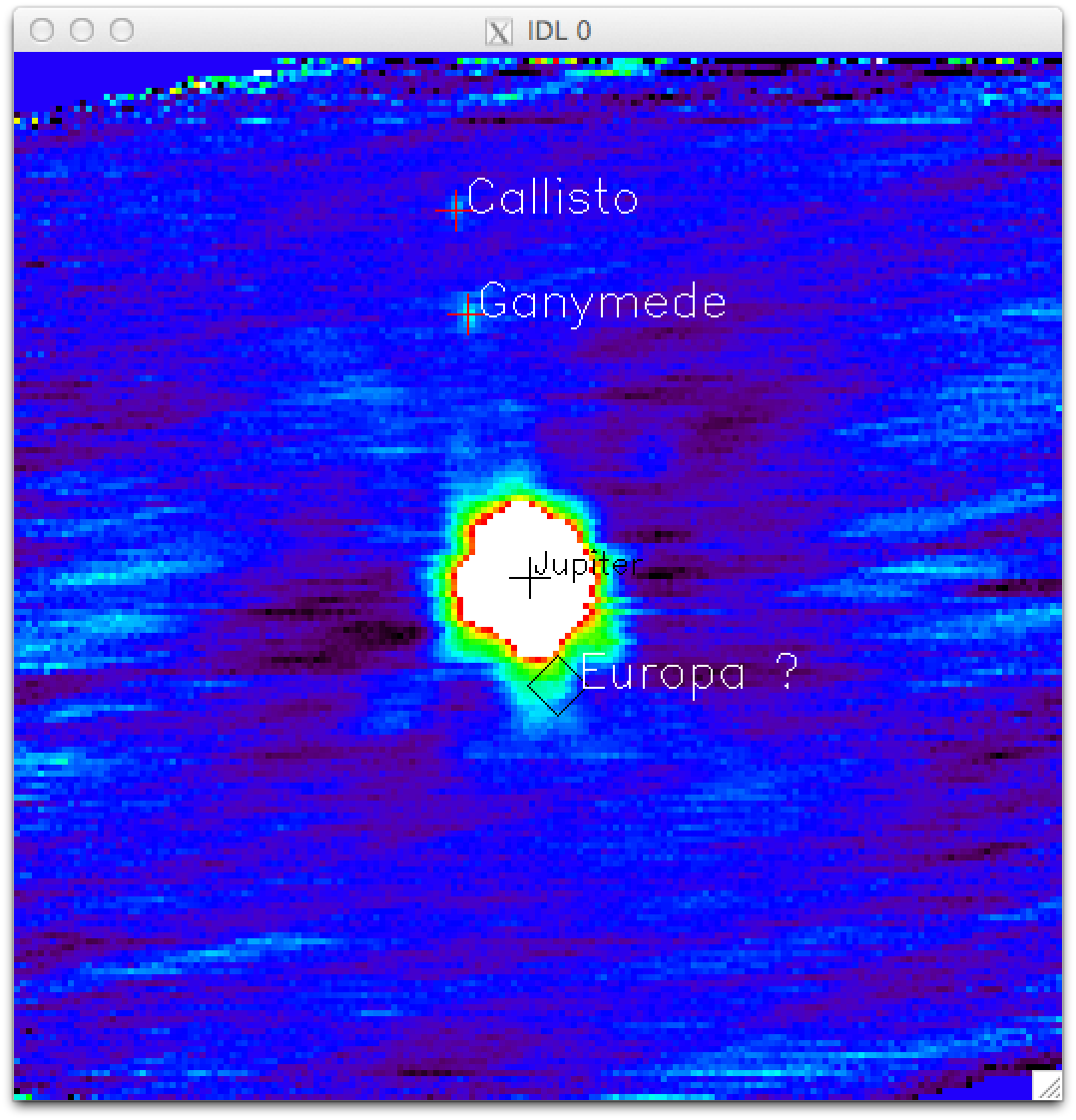
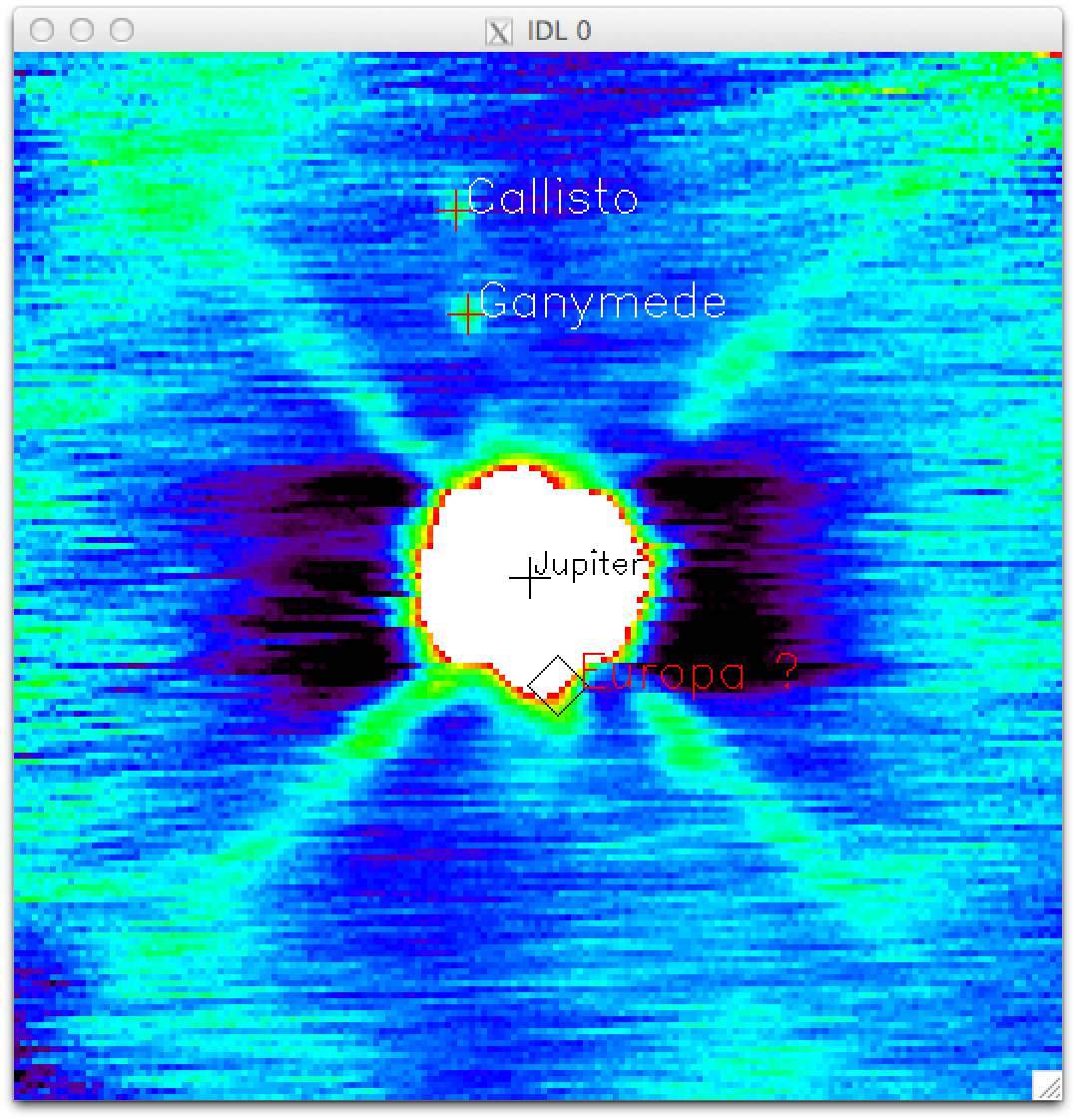
- The coverage at 2mm (grid.nhits_2) is displayed below. The total map is 11.6 x 11.6 arc min on a side. The white square shows the 10 x 10 arc min area indicated by the pako command. Within this area, the coverage is not homogenous, from 130 hits on the edge to 330 in the middle. The dashed area correspond to 250 hits and above, and is 40 square arcmin (6.3 x 6.3 arc min). Maybe we should add a Pako message saying that the homogenous coverage is closer to 6’ x 6’.
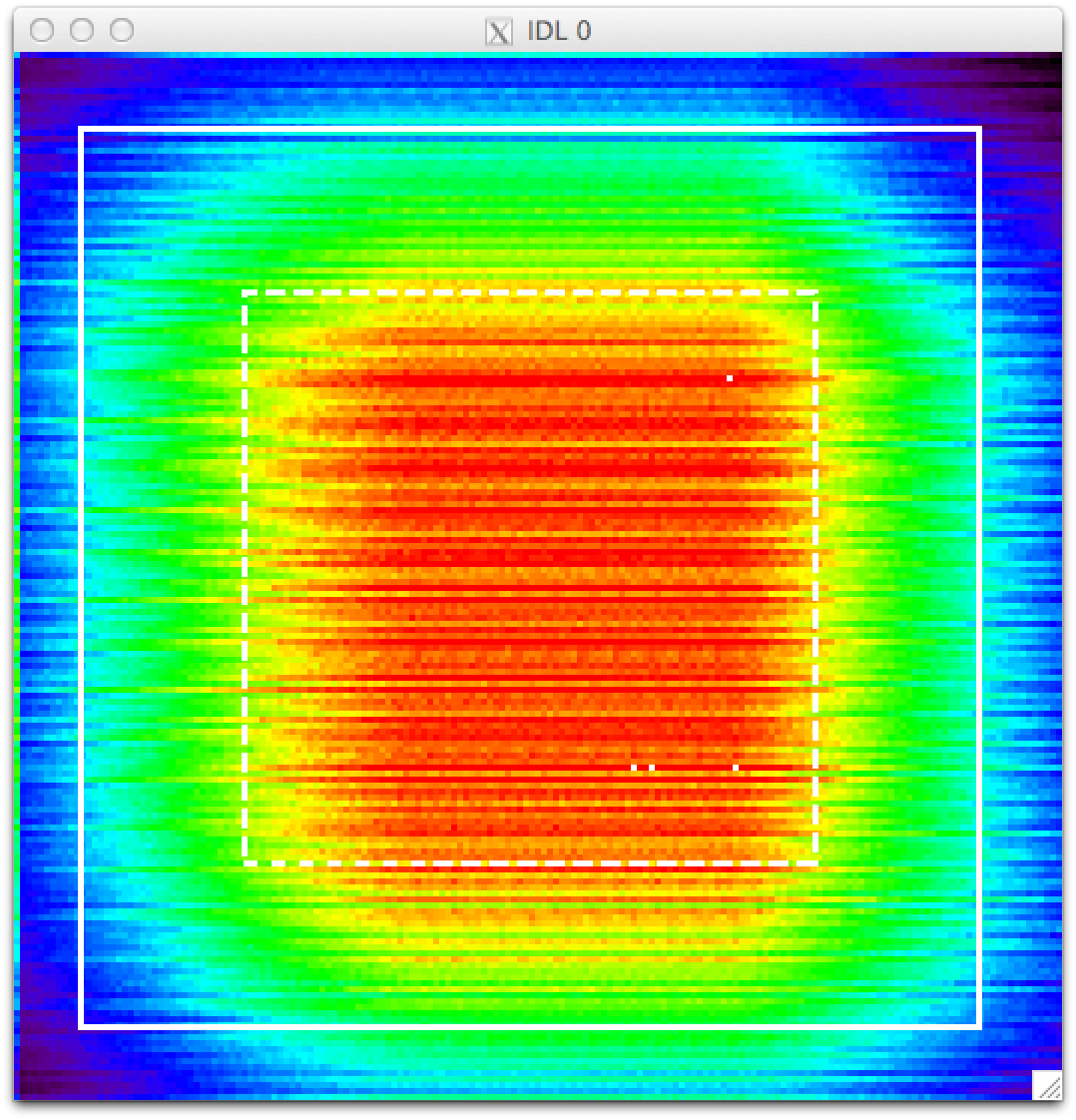
- Observation mode seems OK, except for the remark of the coverage map.
nkotf in azel reference, scan at constant elevation
- Pako command: nkotf 3 10 0 0 30 50azel
Scan number: 20151021s27
- Note: None
Pipeline version: observe@nika2-a.iram.es / branch/Nika2Obs on 2015-10-22:01:00 UT.
- pipeline param:
- param.map_xsize = 700
- param.map_ysize = 700
- param.map_proj: = ‘azel’
- param.decor_cm_dmin = 60.
- param.decor_method = ‘COMMON_MODE_KIDS_OUT’
- results:
- In the 2mm image (left), Ganymede is found at 180”, PA=13, Callisto at 254”, PA = 10. This is in good agreement with Horizon. (again, with convention !order = 1).
- In the array 2 nhits map (right), the scanning at constant elevation is clear. The coverage is inhomogenous. The 3 x 10 arc min expected from the scan is shown by the white rectangle. The coverage in this rectangle goes from 80 to 240 hits...
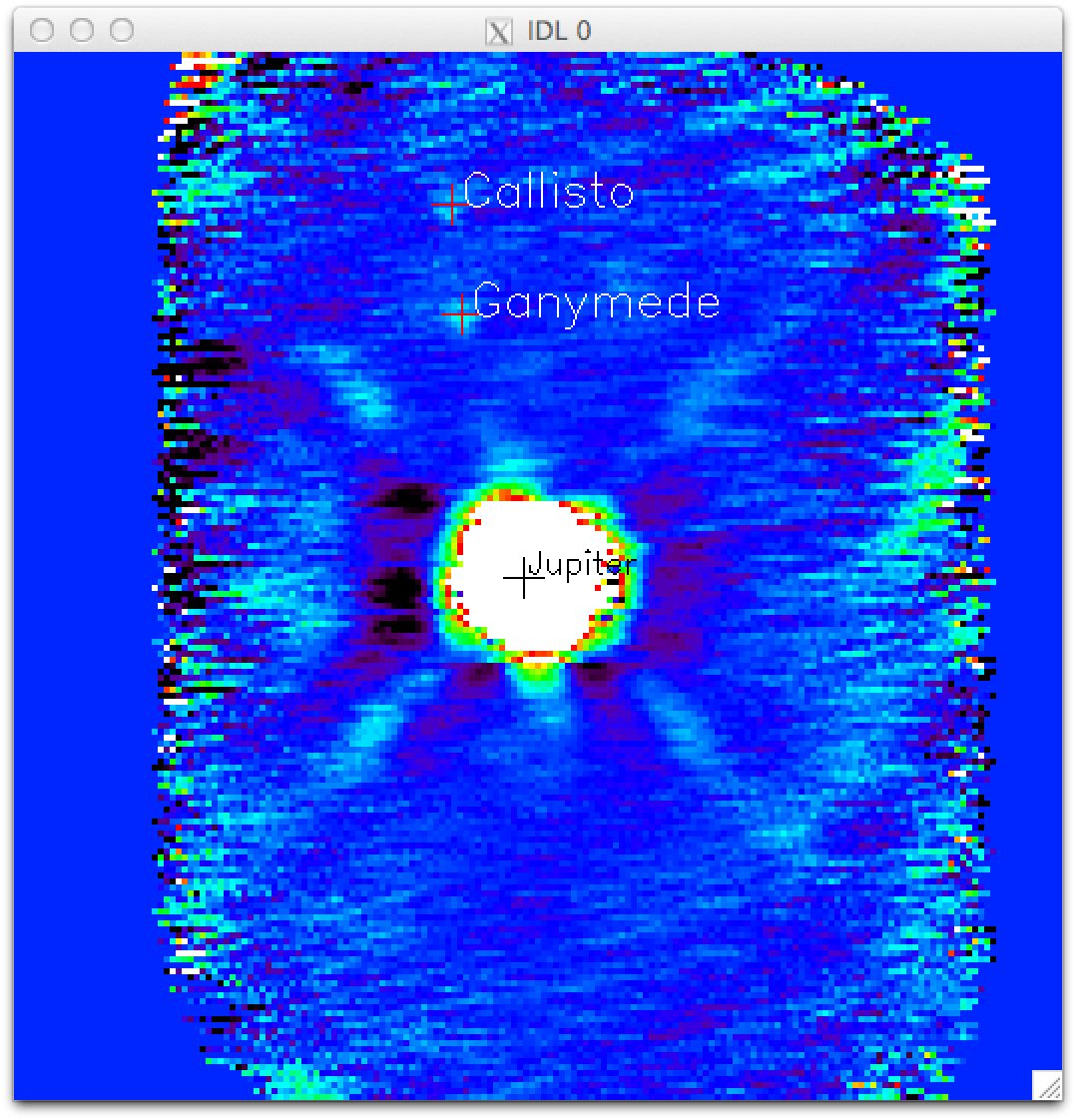
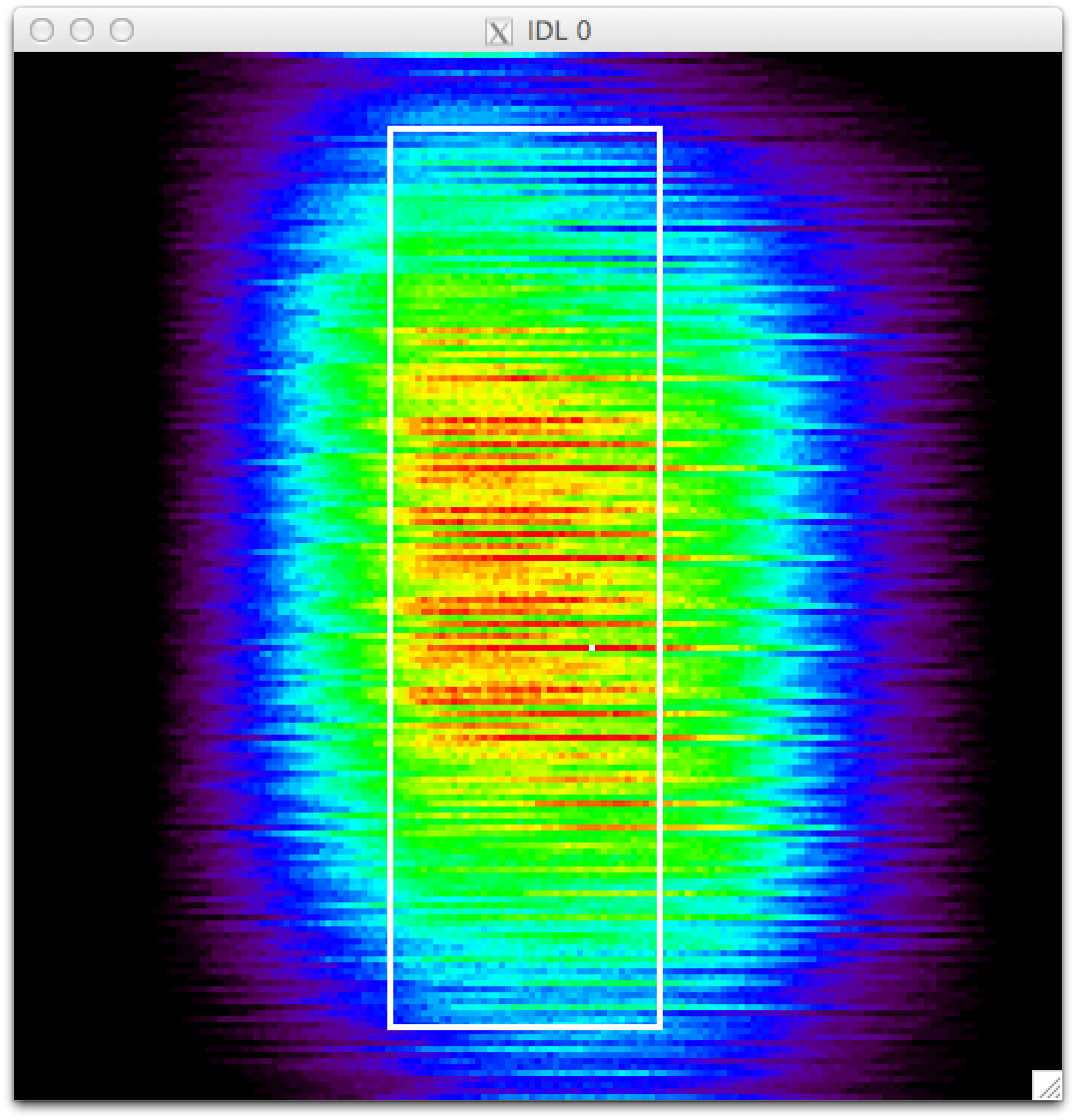
nkotf in azel reference, scan at constant azimuth
- Pako command: nkotf 10 3 90 0 15 50azel (i.e. scan along elevation)
Scan number: 20151021s27
- Note: None
Pipeline version: observe@nika2-a.iram.es / branch/Nika2Obs on 2015-10-22:01:00 UT.
- pipeline param:
- param.map_xsize = 700
- param.map_ysize = 700
- param.map_proj: = ‘azel’
- param.decor_cm_dmin = 60.
- param.decor_method = ‘COMMON_MODE_KIDS_OUT’
- results:
- In the 2mm image (left), Ganymede is found at 181”, PA=12. It is barely visible. Callisto is not visible. This is due to the scanning along elevation, at a time (05:30 UT) where the satellite are almost along the scan axis (12 degree away only). This is in good agreement with Horizon. (again, with convention !order = 1).
- In the array 2 nhits map (right), the scanning at constant azimuth is clear. The coverage is inhomogenous. The 3 x 10 arc min expected from the scan is shown by the white rectangle. The coverage in this rectangle goes from 112 to 236 hits...

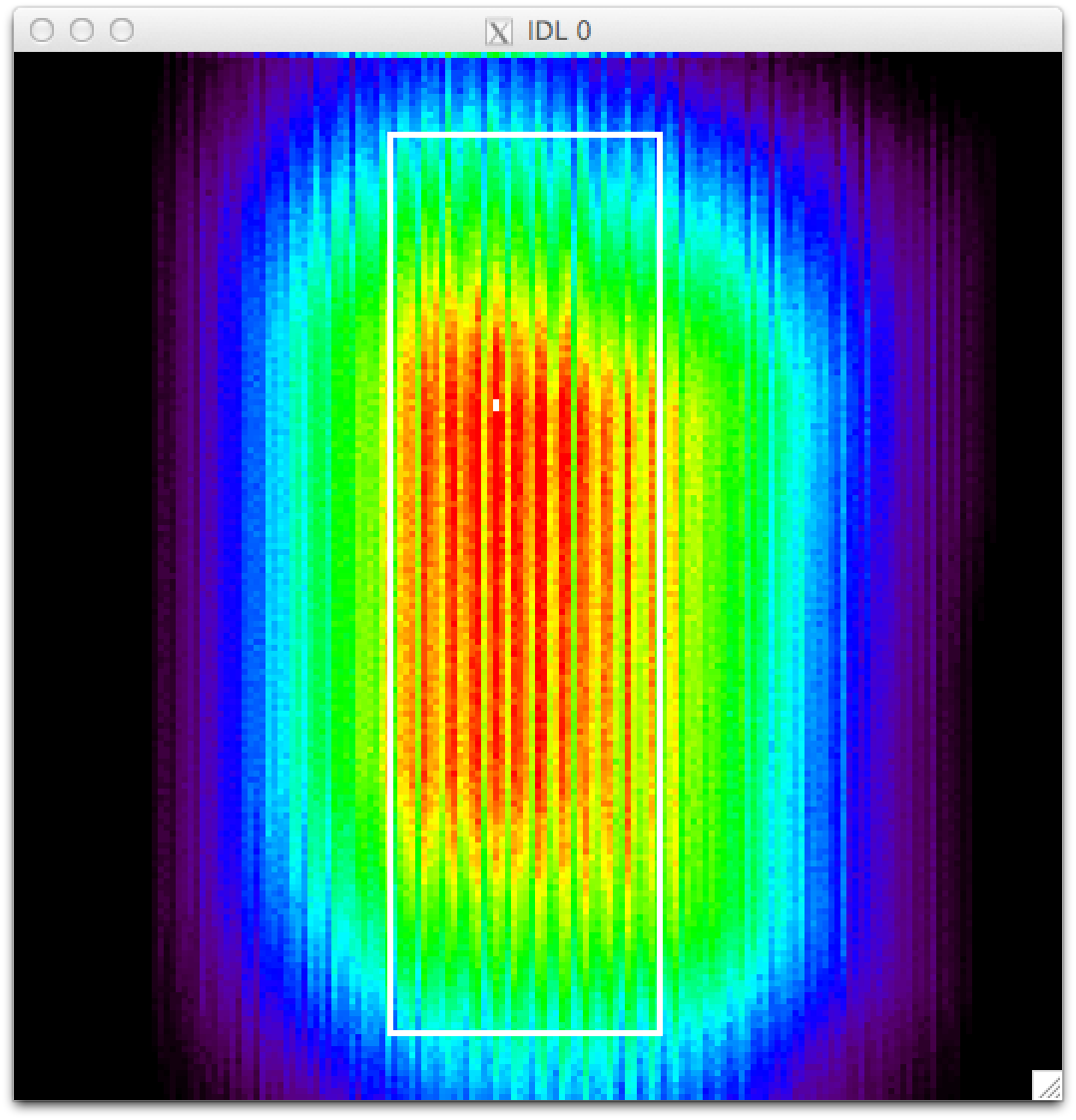
nkotf in radec reference,scan along the RA axis
- Pako command: nkotf 10 10 00 0 15 50 radec (i.e. scan along RA)
Scan number: 20151021s38
- Note: None
Pipeline version: observe@nika2-a.iram.es / branch/Nika2Obs on 2015-10-22:01:00 UT.
- pipeline param:
- param.map_xsize = 700
- param.map_ysize = 700
- param.map_proj: = ‘radec’
- param.decor_cm_dmin = 60.
- param.decor_method = ‘COMMON_MODE_KIDS_OUT’
- results:
- Jupiter is not at the center of the map !!!
- Neither Ganymede or Callisto are to be seen !!!
- The following images display the map, with !order = 1 (left) and !order = 0 (right)
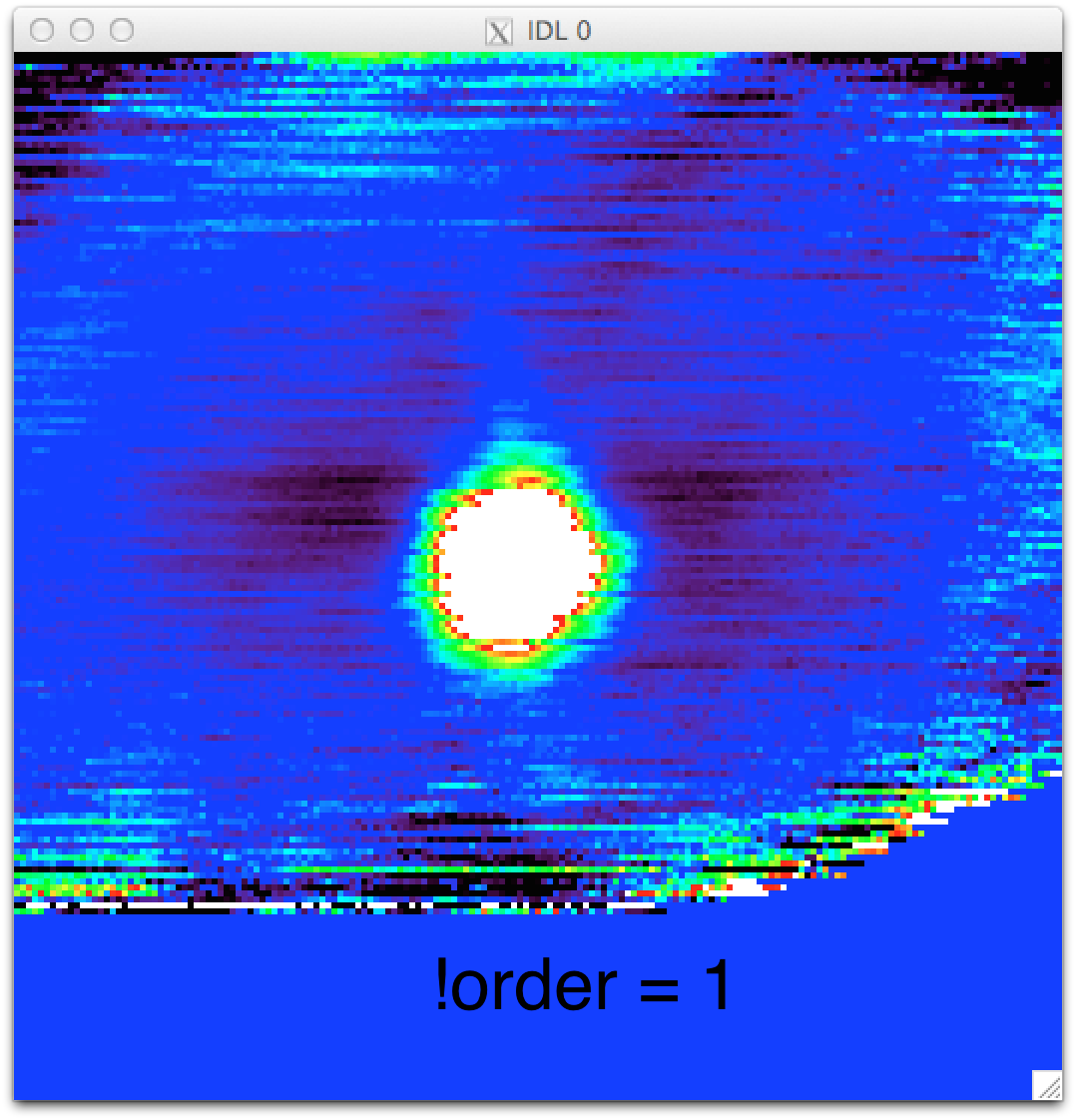

- The following images display the Nits, with !order = 1 (left) and !order = 0 (right). The black cross marks the measured position of jupiter, and the losange (white left, black right) marks the expected position of ganymede, given its PA and distance to Jupiter. A possible reason for the non detection of Ganymede, is that it is in a region of the map with a low hits number, i.e. if the correct orientation is with !order = 0. This will be confirmed with scan 38 below.
- The scan was correctly done along the X (RA) axis. But we are off center by 1/4 of the map size .
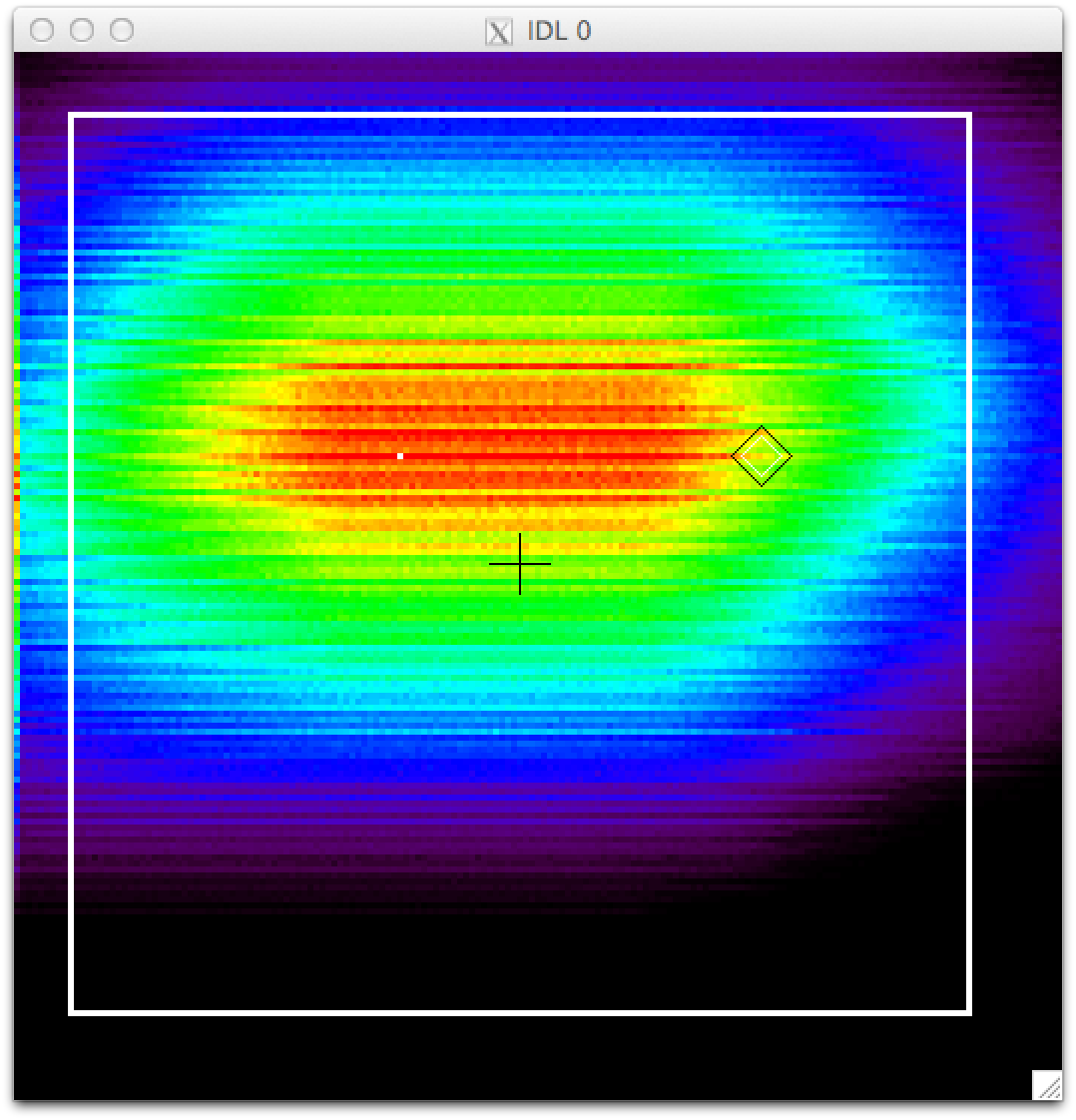

nkotf in radec reference,scan along the Dec axis
- Pako command: nkotf 10 10 90 0 15 36 radec (i.e. scan along Dec)
Scan number: 20151021s38
- Note: None
Pipeline version: observe@nika2-a.iram.es / branch/Nika2Obs on 2015-10-22:01:00 UT.
- pipeline param:
- param.map_xsize = 700
- param.map_ysize = 700
- param.map_proj: = ‘radec’
- param.decor_cm_dmin = 60.
- param.decor_method = ‘COMMON_MODE_KIDS_OUT’
- results:
- Jupiter is not at the center of the map !!!
When displaying the image with !order = 1, Ganynede is found at 169” of Jupiter, PA = -114, Callisto is found at 258”, PA = -117. While the distances are OK, the positions angle do not match the expectation in the ICRF reference frame.
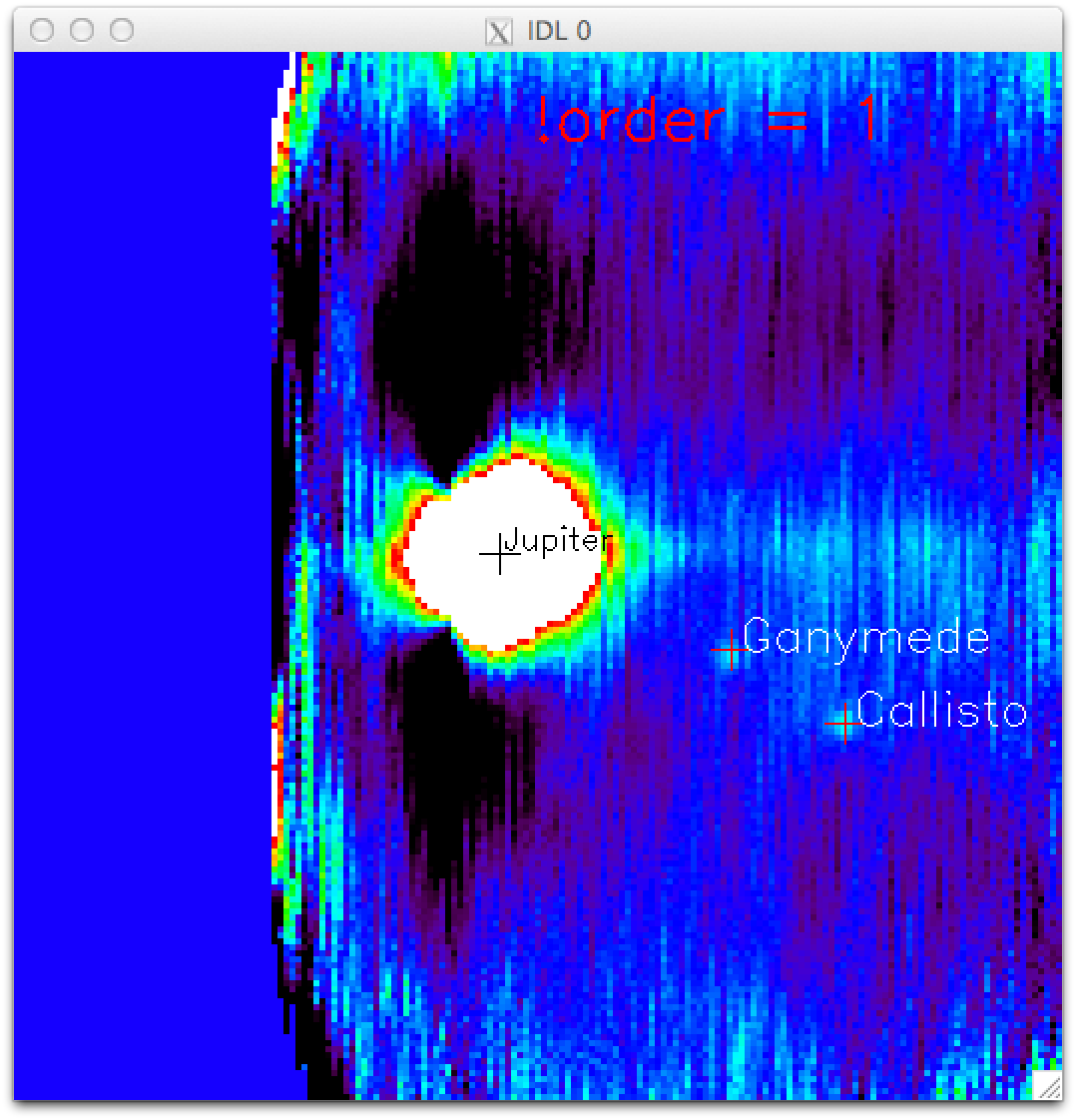
When displaying the image with !order = 0, Ganynede is found at 169” of Jupiter, PA = -66, Callisto is found at 256”, PA = -63 which match reasonably well the expectation in the ICRF reference frame.
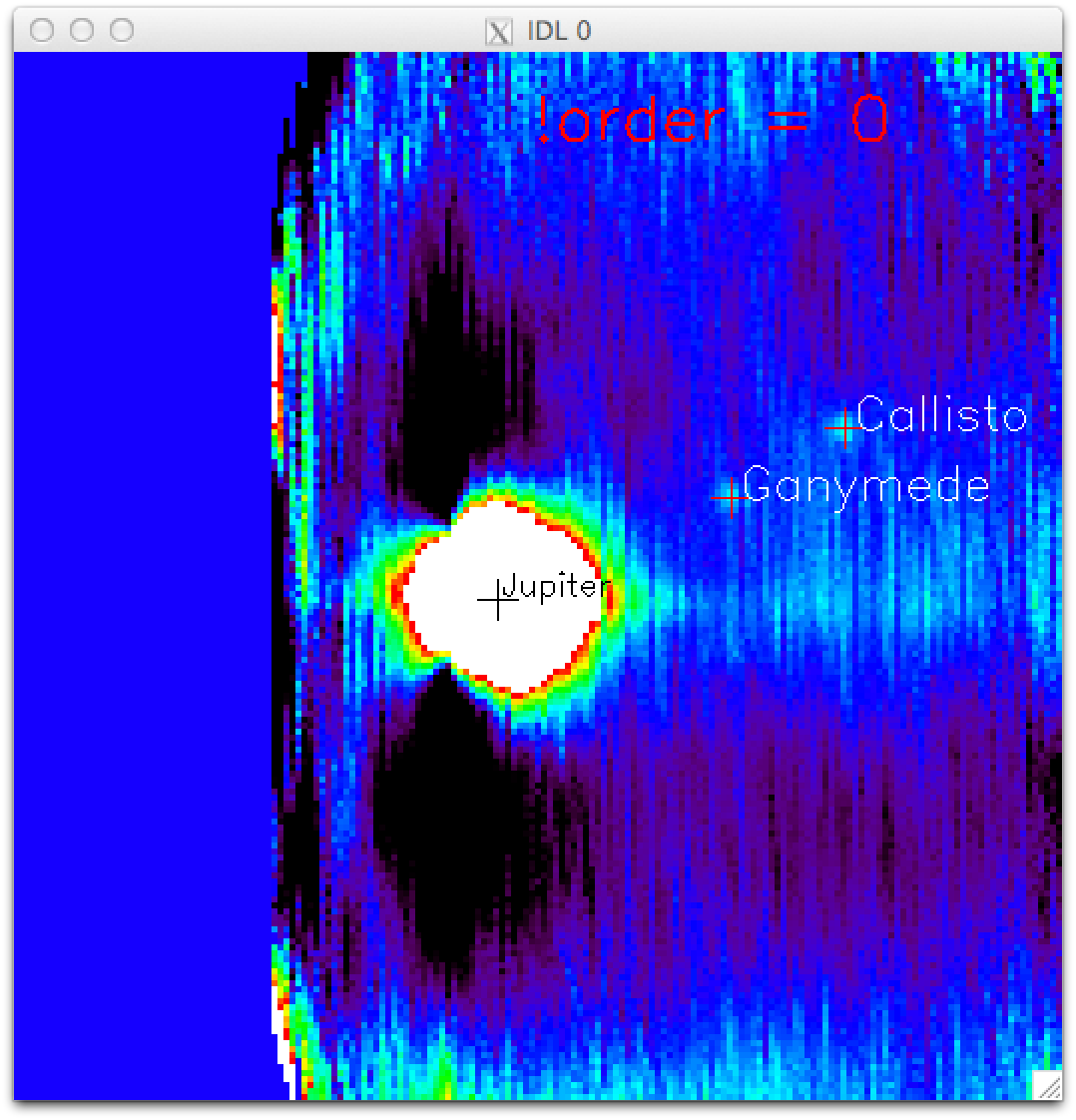
- The grid.nhits_2 confirm that the scan was done along the dec axis, but jupiter is not at the center of the map. The white square is the 10’x10’ expected map, with the cross, marking the position of jupiter. We are off by 2.5’ in RA !
